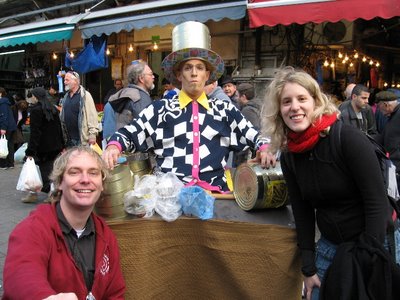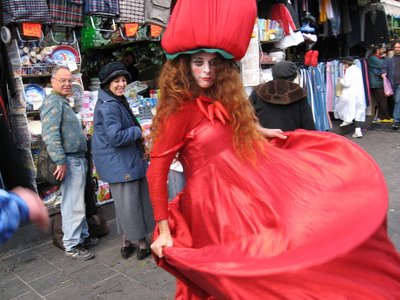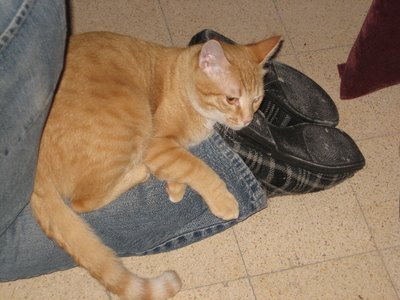
I’m back! The tiyul was fabulous. I came back exhausted and dirty, but it was worth it. We left at 8am on Wednesday to go to the deep south. My grandmother lives in Arad, which is usually the farthest people go down into the desert. Our whole tiyul was much farther – we were in the southern half of the map of Israel, in between Beersheva and Eilat. It was quite unlike the other two trips the school has taken us on, because we didn’t have any text study or Israeli history – it was all geology, natural science and spirituality through nature, plus Reform Judaism through kibbutzim.
First was Ein Avdat, which is a hiking area outside Mitzpe Ramon, a huge crater in the earth. How it got to be a crater is kind of complicated; you can read it
here if you like. The hike lasted about an hour or so, and we saw a waterfall that’s the source of much of the water for wildlife in these parts. Would you believe that when it rains, the water stays in the mountain for over 50 years before it comes out in the waterfall? Crazy. Afterwards we went pretty high up and saw a cave leftover from Byzantine ascetic monks – they lived their whole lives in the desert meditating. (I couldn’t do it.)

This was taken right after we climbed up - the sign says "Abyss Ahead."
After afternoon services and another bus ride, we got to Kibbutz Yahel, one of the two Reform kibbutzim in the Arava, the lower section of the desert and the valley that forms part of the border with Jordan (Arava
link). We picked pomelos, these huge citrus fruits, off the trees – apparently the kibbutzniks call them “pomelos for peace,” because the Jordanians come over the border to collect them, and the local settlements on both sides of the border have a great relationship, in part due to shared fruit.

Picking pomelos.
The next day was the major hike. We had been given two options: the easy hike or the challenging hike. Well, the name was a misnomer: I went on the easy hike, and it was HARD! Thank goodness I didn’t go on the “challenging” hike, I probably wouldn’t have been qualified. We literally hiked up a mountain and then down, through a sandstone canyon and then over more hills. The area is bleak, desolate, and beautiful in its rawness. This is where the Israelites wandered for 40 years – at one point, looking up at the mountain above me that I had yet to climb, I understood why a golden calf seemed like such a good option.

The dots halfway up are people. This was the small mountain before we got to the main one.

Me on the mountain.

Red sandstone in the canyon.
We got back from the hike six hours after we left, and headed straight to our Bedouin tent. The dinner there was particularly delicious (but then again, I’d been hiking for six hours, so I’m sure bread and water would have been scrumptious). It felt like my high school Jewish youth program, as 70 of us were in this huge tent-like structure, sleeping in sleeping bags, giggling at all hours of the night and waking up incredibly early to see if we could catch the sunrise. (And no, I haven’t changed that much, people – I was up at 6:15, but the sun was already high. I’ve only ever seen sunrises from pulling all-nighters).
Friday morning we went to Kibbutz Lotan. It’s the other Reform kibbutz in the area, and is well-known for its ecology. It’s a Green Party member’s dream. This place was so original, I’ve never seen anything like it. The majority of their buildings are made from mud brick and trash. Literally, old tires, tin cans, bottles, etc, all put together with hay stacks and mud to make a building. They have compost toilets that use no water, a bird park and vegetable garden with no pesticides, watsu and water massage, etc. The kibbutz has about 150 people on it and four cars for all. It’s socialism and ecology to the extreme, and though I think I’m a bit too capitalist to live there, it was fascinating to explore.

Me at the entrance to Kibbutz Lotan. My camera batteries died right as we got there, so I'll have to collect pictures of the inside of the kibbutz later. Know that the wall is made of garbage and mud brick.
I also learned one interesting Biblical piece: the Jews became slaves in Egypt because Pharaoh refused to give them straw to use in making brick, and so they went into debt and became slaves. I never really knew what that meant until I actually *made* mud brick at Lotan. First we mixed together dirt and water and shaped it into mud patties – they broke apart. Then we did it again adding straw – and the things stuck together! We put the mud/straw mixture into metal frames so they took on a square shape. After we packed it in well, we took off the frame, and there we had a mud brick! The whole process took under two minutes. Imagine, said the man from Lotan, if instead of the Red Cross sending out metal and insulation to make buildings in 3rd world countries, they send out people to ask the local elders their recipe for mud brick. I don’t know how well that will work in reality, but the whole experience definitely gave me something to chew on. If you want more info on Kibbutz Lotan go
here.
After Lotan we headed straight down to Eilat and snorkeled the coral reserve. The water was freezing, but the fish were pretty. (To tell the truth, I was a bit disappointed, they had built it up so much. I have to remember though that the last time I went snorkeling was at the Great Barrier Reef, so I can’t really compare). Anyway, once we got all cleaned up back at the kibbutz, we had dinner and services. The best part of the day was oneg Shabbat with Rabbis Elyse Frishman and Danny Freelander. They’re kind of the who’s who of rabbis – she’s the editor of the new prayerbook that’s coming out, and he’s the vice-president of the Union of Reform Judaism. Their talk was amazing, completely inspiring – they gave a sort of biography of their lives, and discussed the challenges and experiences that have shaped them as rabbis. I want to be them one day!
Since Jonathan didn’t come with me on the tiyul, I roomed with Melanie, and it was great. She performed in a cantorial concert in the evening, and then the next morning, she read Torah and two other cantors led services. Lev, the man who had read Torah for the first time last month, gave the d’var Torah. It was really, really good. This week’s Torah portion is all about the details for how to build the ark, this cubit by that cubit from this wood and that measurement, etc. Lev shared with us that his father was a carpenter and a “joiner,” specializing in the joining of different pieces of wood. Joiners like trees like maple or oak, because the slabs of wood can be bigger, and there’s less joining. Yet the ark has to made out of acacia wood, which is a relatively small tree. Lev then jumped to the bus rides on the tiyul; he had sat across from me, and our section of the bus had spent the time debating the nature of prayer, what is kashrut and should Reform Jewish camps keep kosher, what are the differences of values between Reform and Conservative, what makes a service a service, etc. He said that just as the ark is made from multiple joined pieces of wood, Judaism is a tapestry of different opinions. Only after all the pieces have been joined together can you create a whole community, just as only after the ark is made of multiple pieces of acacia wood can you create the solid gold covering on top. I loved the parallel.
Following the service we spoke with a panel of kibbutz members and their teenaged children about being a kibbutz in 2007. Obviously the original socialist model wasn’t working. How do they separate the kibbutz community from the agricultural business, how do they distribute money (since most of them have jobs outside the kibbutz), what is the difference between members, who own the kibbutz, and residents, who rent, and how is Reform Judaism integrated into daily life? It was quite interesting, and not at ALL the Hebrew school model of what I thought kibbutzim would be. Once the panel ended, I went to nap, and then after another short Havdallah service to end Shabbat, we headed home. The bus ride was so choppy I was glad to be on solid, unmoving land, and so I got home at 10pm and headed right to bed!
Click
here for the rest of the pictures.


















